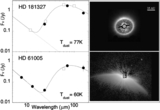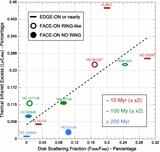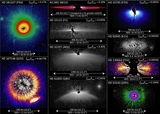Image Details

Caption: Figure 5.
Comparison of PSF-subtraction methods revealing the HD 181327 debris ring in HST coronagraphic images with ((A)–(D)) derived from the same raw data (NICMOS 1.1 μm imagery) and (E) STIS six-roll (6R) contemporaneous observationally matched-PSF template-subtracted coronagraphy (PSFTSC). (A) NICMOS discovery image using 2 (of 10) non-contemporaneously observed PSF template stars (Schneider et al. 2006; HST GO program 10177). (B) "LAPLACE" (HST AR program 11279) re-processing and globally optimized re-reduction with PSF-matching from a down-selected 53 template ensemble (Schneider et al. 2011). (C) LOCI re-processing (without regularization) with a 232 LAPLACE recalibrated PSF template library. (D) KLIP re-processing (35 coefficients) using same PSF template library as panel (C) with regularization. (C) and (D) from Soummer et al. (2012; HST AR program 12652). (E) STIS 6R-PSFTSC (the result from this program is discussed in this paper). The gray circle indicates the location and size of the NICMOS r = 0![]() 3 coronagraphic circular obscuration.
3 coronagraphic circular obscuration.
Copyright and Terms & Conditions
© 2014. The American Astronomical Society. All rights reserved.












